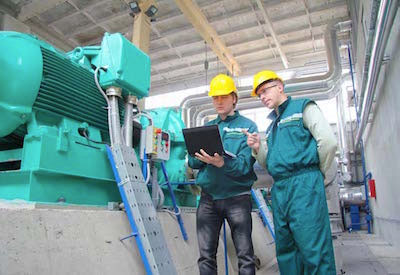How the IIoT Is Delivering on Asset Performance Management, Part 4

Nov 6, 2017
By John Boville
Part 1 of this 4-part series introduced ways in which increasing digitization might improve plant operations. Part 2: how IIoT can improve the productivity of reactive, preventive, predictive and proactive maintenance. Part 3: five converging trends. Here in Part 4: how IIoT is already improving operational profitability.
Whether you call them advanced PLCs, IIoT-ready PACs, or ePACs, modern controllers are enabling engineers to control their most important risks, whether they are in a process, batch, or hybrid operation: safety/ environmental risk (including cybersecurity risk), reliability risk, efficiency risk, and profitability risk.
The measurable business value that can be derived from this new generation of controllers makes upgrading easy to justify, even in times of continuing downward pressure on capital costs. With the right models, companies involved in brownfield or greenfield modernization automation projects may see 100% returns on their controller investment in as little as three months.
Here are just some of the ways new ePACs equipped for IIoT are already having an impact on operational profitability:
• Increased productivity. Using such advanced ePACs, a feed mill in Vietnam, for example, has achieved 3 times faster feed production. And by standardizing on one control products family, it has cut cabling costs significantly. Overall, the mill has increased production by 3%, and reduced costs by 30%.
• Increased operational visibility. Lacking precise data on asset location, process status, etc., can cost up to 3% of yearly revenue — and create a significant margin shortfall for the typical discrete/hybrid manufacturing plant, with substantial bottom-line impact. An ePAC automation project with transparent open native networks can bring much-needed operational visibility.
• Cost-efficient energy management. Calculations show it’s possible to reduce annual energy consumption at an average large facility from US$6 million to about US$4.8 million by making energy usage data more efficient and transparent.
• Cybersecurity protection. Manufacturers now have a 32% chance of experiencing a hostile cyber-event or cyberattack in any given year.[1] Using advanced ePACs in key roles within comprehensive plantwide cybersecurity strategies can drastically reduce the likelihood of cyberattacks — critical in a world where the total costs of a data breach average more than US$3.7 million.[2] Thus the increases in business value that can be derived from this new generation of controllers make upgrading easy to justify, even in times of continuing downward pressure on capital costs.
Most maintenance teams already have in place much of the technology they need to take advantage of the IIoT. Industry groups and standards organizations are gearing up to provide guidance. As we have seen above, NAMUR, for example, is beginning to articulate the vision for a new generation of digital maintenance, addressing IIoT in the context of broader Industry 4.0 initiatives and seeking to understand the entire transformation of industry, one that incorporates IIoT, mobile, cloud, digital augmented reality and other advances.
And the FDT organization, a true pioneer driving standards for device diagnostics, has just announced a standards-based, FDT/IIoT Server for mobility, cloud, and enterprise applications. The server features robust layered security leveraging vetted industry standards and utilizing encrypted communications with transport layer security. It also takes advantage of an OPC Unified Architecture (OPC UA) annex enabling sensor-to-cloud, enterprise-wide connectivity for industrial control systems used in the process, hybrid and factory automation markets. Together, FDT and OPC UA allow sensor, network and topology information to permeate the enterprise, including mobile devices, distributed control systems, programmable logic controllers, enterprise resource planning systems, the cloud, and the IIoT and Industry 4.0.
With so much going on, it is easy to become overwhelmed and take a wait-and-see approach. But your operations don’t sit still. The good news is that IIoT is not an all or none proposition. Industrial digitization with will increase steadily over time. The most strategic approach is to identify which assets are most vital to your company’s profitability today and begin the dialogue about whether better information about their operating histories and performance can help improve their availability and utilization.
That should lead to an understanding of what types of control, if any, you might need to achieve those benefits.
John Boville is a marketing manager for Schneider Electric’s marketing and innovation group, where he focuses on the Modicon controller line. He has been with Schneider Electric industrial automation for more than 25 years, including implementing market segment strategies for the automotive industry. Prior to joining Modicon, before it became part of Schneider Electric, he served for 12 years in project engineering for CEGELEC Automation as an industrial system designer, installation specialist, and project leader for large automation migration projects. He holds a B.S. in electrical engineering from the University of Bradford, U.K. Keep up with John’s latest insight in his blog: http://blog.schneider-electric.com/author/jboville/
Photo source: Schneider.
Read Part 1 (an introduction to how increasing digitization might improve plant operations), Part 2 (how IIoT can improve the productivity of reactive, preventive, predictive and proactive maintenance), and Part 3 (five converging trends).
For more information visit www.schneider-electric.com/m580
References
1. “The State of Security in Control Systems Today: A SANS Survey,” by Derek Harp and Bengt Gregory-Brown, page 1, June 2015, at https://www.sans.org/reading-room/whitepapers/analyst/state-securitycontrol-systems-today-36042
2. “2015 Cost of Data Breach Study: Global Analysis,” page 1, Ponemon Institute LLC, May 2015, at http://www01.ibm.com/common/ssi/cgibin/ssialias?subtype=WH&infotype=SA&htmlfid=SEW03053WWEN&attachment=SEW03053WWEN.PDF

















